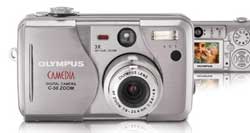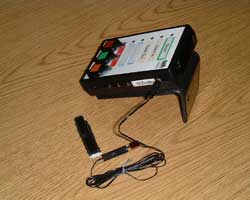A Custom Modification to Enable A Person with a Cervical Spinal Cord Injury to Control a Digital Camera
ABSTRACT :
Bill sustained a C4/5 spinal cord injury that prevented him from pursuing his hobby of photography. This paper describes how a Tash Mini Relax was modified so that Bill could control the "shoot", "zoom-in" and "zoom-out" functions of an Olympus (Model C-50 Zoom) digital camera.
KEYWORDS:
Cervical spinal cord injury, photography, adapted access, digital camera.
BACKGROUND:
Bill sustained C4/5 spinal cord injury in a motor vehicle accident. As a result of his injuries, he has no movement in his lower limbs, good range of motion at the elbows and shoulders, some wrist extension but no discrete finger movement. He is able to position his hand in such a way that he is able to activate buttons with no less than a ½" diameter. He is unable to manipulate objects such as TV remote controllers. Bill uses a powered wheelchair with a modified joystick for mobility. Bill's speech, hearing and cognition are within normal limits. He has a pre-existing visual impairment. During assessment for electronic aids to daily living (EADL), Bill identified the desire to control a camera so that he could resume his hobby of photography. This was particularly important because Bill was due to retire two weeks after his accident. He had planned to spend his retirement enjoying outdoor activities that included photography. Bill had already purchased an Olympus (Model C-50 Zoom) digital camera with an infrared remote control that is intended to be used for self-portraits. It is capable of controlling zoom in and out and shutter control.
Methodolgy:
Before a custom camera modification was conducted, a search was made to find if any modified cameras were being manufactured. An Internet search revealed two digital cameras and a Polaroid camera that were modified for switch activation of the shutter control. No cameras were found that would provide Bill with a greater degree of control. Bill requested a custom modification of his existing Olympus (Model C-50 Zoom). He agreed to pay for the work.
 |
|---|
The Olympus C-50 digital camera comes with an infrared receiver on the front of the unit and an infrared remote control (RM-1). The remote can control 3 functions, zoom in and out and shutter control. The receiver only has about a 30-degree range for receiving. The C-50 model did not have an infrared port on the back of the unit (some models now have this) and Bill needed the camera to face away from him while he controlled it.
 |
|---|
A Tash Mini Relax (with Jacks) was selected to replace the existing remote control because it has the ability to learn IR signals and is relatively inexpensive. The Mini Relax was modified with a 3.5 mm jack to accept a stick-on infrared (IR) emitter LED used by many home theater control systems. Bill's wife also uses the camera so the emitter could not be directly attached the camera. A clear plastic extension was added to the quick release part of the camera mount and the IR emitter was attached to that. With this, the IR emitter is positioned directly in front of the IR receiver on the camera, but the camera can be easily removed by itself.
 |
|---|
The Mini Relax was further modified with three Tash Trigger switches mounted directly on the lower front of the Mini Relax and hardwired to the first three switch inputs. By removing the existing switch jacks and hardwiring these three switches, it allowed us to place the IR emitter jack into one of these now vacant holes without having to drill another hole into the case. The other two holes were covered by the IR emitter port label.
Bill already had an existing Communication Station mounting system on his wheelchair for a TouchScreen EADL, placed at midline. The mount uses a Communication Station Wedge Base with Pin to connect the TouchScreen onto a horizontal bar running perpendicular to his legs. Since Bill doesn't bring the TouchScreen when traveling far away from home this provided an easy place to start. A ¼" piece of ABS (plastic) was shaped at one end to the same dimensions as a Communication Station Wedge Plate and then bent at the same angle as the TouchScreen. This is attached by Velcro to the bottom of the Mini Relax. The result is one unit that can be easily attached and removed.
The camera mount is attached to Bill's wheelchair seat. Bill uses the wheelchair joystick to control left, right, and to move closer in or out. He uses the wheelchair's tilt feature to change the camera angle.
One drawback is that the remote control cannot "turn on" the camera. The shutter button on the top of the camera must be depressed. Bill is able to do this independently so no further modification was required.
RESULTS:
Bill has demonstrated his ability to use the Trigger switches mounted as described above but has not used the finished product. The modified controller is now complete and working well with the camera. It will be sent to Bill by mail, as no expert set-up is required. No problems are foreseen with Bill's ability to use it. Bill will require assistance to download the photographs onto his computer but has existing adapted access methods for his computer and will be independent in editing the photographs. The parts for the modification cost approximately $650 (Canadian) and took 8 hours of labour.
Bill is looking forward to exploring the countryside around his lakefront retirement home and enjoying the new hobby he had planned before his accident.
DISCUSSION:
People with cervical spinal cord injuries are limited in their ability to actively participate in leisure activities. The camera modification described above was designed specifically for Bill who has a C4/5 spinal cord lesion and some hand function. A Tash Mini Relax with jacks was used in order to provide a direct method of access. A similar modification could be made using the scanning Tash Mini Relax. Such a modification would enable people with higher spinal cord injuries as well as people with a much broader range of disabilities to control a camera and enjoy a creative leisure activity.
James Leslie
Rehabilitation technologist, Manager
Independence Technologies, Hamilton
Health Sciences
Suite 111, Osler Building,
Box 2000, Hamilton,
Hamilton, Ontario, Canada
L8N 3Z5
Phone (day time): (905) 521 2353
Fax: (905) 521 4964
E-mail: leslie@hhsc.ca
ORCCA Technology. ORCCA Technology, Inc. 444 East Main Street, Suite 101, Lexington, KY 40507 Phone: 859-226-9625 Fax: 859-226-0936, E-mail: orcca@orcca.com. Web site: www.orca.com
Tash International Inc. Unit 1, Station Street, Ajax, Ontario, Canada, L1S 3H2. Phone: 800 463 5685. Fax: 905 686 6895 Web site: www.tashinc.com
